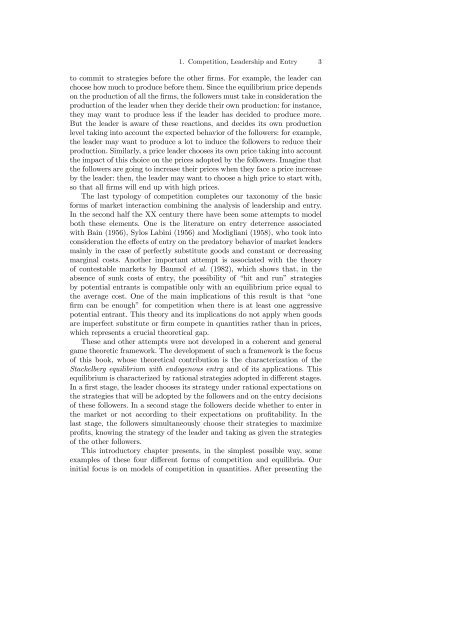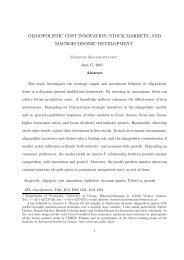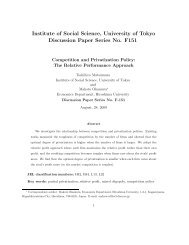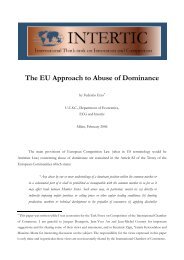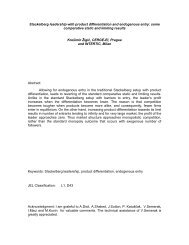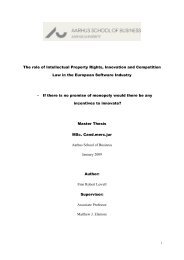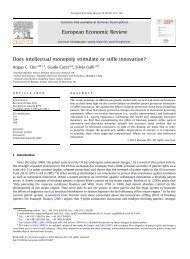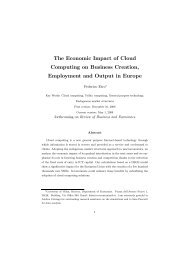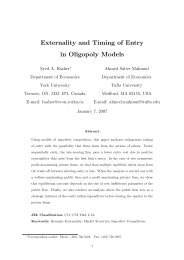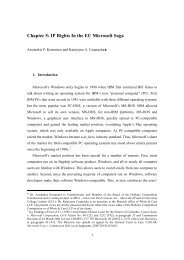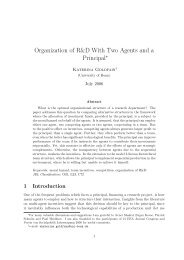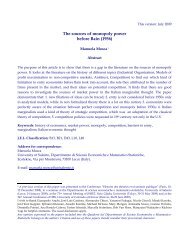Competition, Innovation, and Antitrust. A Theory of Market ... - Intertic
Competition, Innovation, and Antitrust. A Theory of Market ... - Intertic
Competition, Innovation, and Antitrust. A Theory of Market ... - Intertic
Create successful ePaper yourself
Turn your PDF publications into a flip-book with our unique Google optimized e-Paper software.
1. <strong>Competition</strong>, Leadership <strong>and</strong> Entry 3<br />
to commit to strategies before the other firms. For example, the leader can<br />
choose how much to produce before them. Since the equilibrium price depends<br />
on the production <strong>of</strong> all the firms, the followers must take in consideration the<br />
production <strong>of</strong> the leader when they decide their own production: for instance,<br />
they may want to produce less if the leader has decided to produce more.<br />
But the leader is aware <strong>of</strong> these reactions, <strong>and</strong> decides its own production<br />
level taking into account the expected behavior <strong>of</strong> the followers: for example,<br />
the leader may want to produce a lot to induce the followers to reduce their<br />
production. Similarly, a price leader chooses its own price taking into account<br />
the impact <strong>of</strong> this choice on the prices adopted by the followers. Imagine that<br />
the followers are going to increase their prices when they face a price increase<br />
by the leader: then, the leader may want to choose a high price to start with,<br />
so that all firmswillendupwithhighprices.<br />
The last typology <strong>of</strong> competition completes our taxonomy <strong>of</strong> the basic<br />
forms <strong>of</strong> market interaction combining the analysis <strong>of</strong> leadership <strong>and</strong> entry.<br />
In the second half the XX century there have been some attempts to model<br />
both these elements. One is the literature on entry deterrence associated<br />
with Bain (1956), Sylos Labini (1956) <strong>and</strong> Modigliani (1958), who took into<br />
consideration the effects <strong>of</strong> entry on the predatory behavior <strong>of</strong> market leaders<br />
mainly in the case <strong>of</strong> perfectly substitute goods <strong>and</strong> constant or decreasing<br />
marginal costs. Another important attempt is associated with the theory<br />
<strong>of</strong> contestable markets by Baumol et al. (1982), which shows that, in the<br />
absence <strong>of</strong> sunk costs <strong>of</strong> entry, the possibility <strong>of</strong> “hit <strong>and</strong> run” strategies<br />
by potential entrants is compatible only with an equilibrium price equal to<br />
the average cost. One <strong>of</strong> the main implications <strong>of</strong> this result is that “one<br />
firm can be enough” for competition when there is at least one aggressive<br />
potential entrant. This theory <strong>and</strong> its implications do not apply when goods<br />
are imperfect substitute or firm compete in quantities rather than in prices,<br />
which represents a crucial theoretical gap.<br />
These <strong>and</strong> other attempts were not developed in a coherent <strong>and</strong> general<br />
game theoretic framework. The development <strong>of</strong> such a framework is the focus<br />
<strong>of</strong> this book, whose theoretical contribution is the characterization <strong>of</strong> the<br />
Stackelberg equilibrium with endogenous entry <strong>and</strong> <strong>of</strong> its applications. This<br />
equilibrium is characterized by rational strategies adopted in different stages.<br />
In a first stage, the leader chooses its strategy under rational expectations on<br />
the strategies that will be adopted by the followers <strong>and</strong> on the entry decisions<br />
<strong>of</strong> these followers. In a second stage the followers decide whether to enter in<br />
the market or not according to their expectations on pr<strong>of</strong>itability. In the<br />
last stage, the followers simultaneously choose their strategies to maximize<br />
pr<strong>of</strong>its, knowing the strategy <strong>of</strong> the leader <strong>and</strong> taking as given the strategies<br />
<strong>of</strong> the other followers.<br />
This introductory chapter presents, in the simplest possible way, some<br />
examples <strong>of</strong> these four different forms <strong>of</strong> competition <strong>and</strong> equilibria. Our<br />
initial focus is on models <strong>of</strong> competition in quantities. After presenting the


